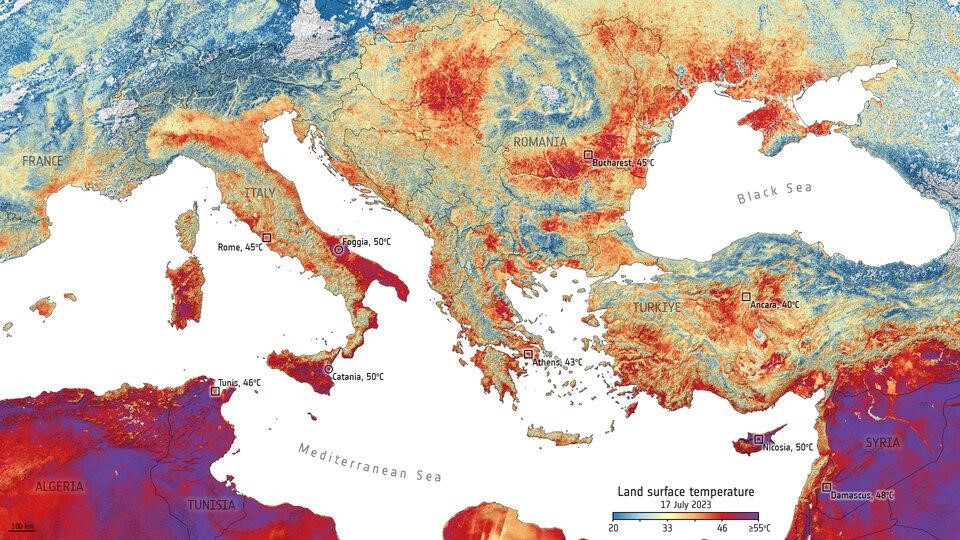It is a scorching summer in Europe. No thanks to an extreme heat wave breezing across the region which has pushed temperatures to all-time highs. In Italy, temperatures are predicted to soar to a blistering 45°C, surpassing a record 48.8°C seen in Sicily in 2021. The situation is not much different in Greece where wildfires have compounded the woes of millions.
Fatality, morbidity, and the reality…
The growing frequency of extreme weather events further confirms that climate change is an increasing emergency. And it is not just about this current summer. A recent report from the Guardian revealed that between May 30 and September 4, 2022, heat claimed the lives of more than 61,000 people across Europe. The summer of 2022 was recorded as Europe’s hottest due to a relentless barrage of record-breaking heat waves. Findings highlight the gravity of the situation, revealing Italy’s staggering death toll at 18,010, followed by Spain and Germany, reporting 11,324 and 8,173 heat-related deaths, respectively. This is the grim possibility that may become a reality in 2023 given the way things are going with the heatwaves.
The climate emergency is it…
The current heat wave can be attributed to a combination of factors, including a high-pressure system, naturally occurring weather patterns, and human-induced climate change. The current heatwave in Europe, named Cerberus after the mythological three-headed guardian of the underworld, is caused by an anticyclone. An anticyclone is a normal meteorological occurrence where sinking air leads to dry, settled weather with minimal clouds and wind. These slow-moving high-pressure systems can persist for days or weeks, becoming semi-permanent features over large land areas. When they form over hot regions like the Sahara, the system’s stability amplifies temperatures, heating the already warm air even further. Another contributing factor is unusually high sea surface temperatures, which means that cooler air is not blowing inland off the Mediterranean. High carbon-emitting human activities have combined to compound a rather natural phenomenon. A picture of the earth showing the land surface temperature on July 17, 2023, is presented below. It was received from the Copernicus Sentinel-3 instrument and is available at the European Space Agency.
Health and economic worries…
As we have already seen, heatwaves are the primary cause of death in Europe among weather- and climate-related events, and without control measures, the frequency of extreme heat episodes could lead to higher morbidity and mortality. According to the WHO, mortality due to heat among people over the age of 65 has nearly doubled over the past two decades, with deaths in the European Region alone rising by more than 30%. Heatwave-related health outcomes impact particularly the aged and aging, pre-existing medical conditions, and escalates social deprivation. Additionally, individuals with chronic illnesses, pregnant women, outdoor labourers, and people living in socially and economically disadvantaged areas also fall into vulnerable categories. Important health issues with heat waves include stress and dehydration, or indirect effects such as cardiovascular, respiratory, renal, and electrolyte issues, usually manifesting within three days of exposure.
The negative impact of heat waves also has wide-ranging economic implications. Findings show that between 2015 and 2019, the economic impact of heat-related health effects cost the European Region an estimated €23.2 billion in mortality, €2.3 billion in minor restricted activity days, and €0.031 billion in morbidity.
What we should do…
There is no doubt that the European heatwave requires concerted proactive attention and action. Given that the frequency of the event poses a significant threat to public health, particularly among vulnerable populations, increases the mortality rate, spreads climate-sensitive infectious diseases, and so on, stakeholders must work together to address this common threat. Actions that can be taken to address the human-induced causes of climate change, such as urban greening, efficient housing and infrastructure, and flexible working arrangements for the labour force, should be escalated. Mitigating the health impacts of heat will require concerted political efforts and strategies.
Found it interesting and would like more in the mail?




